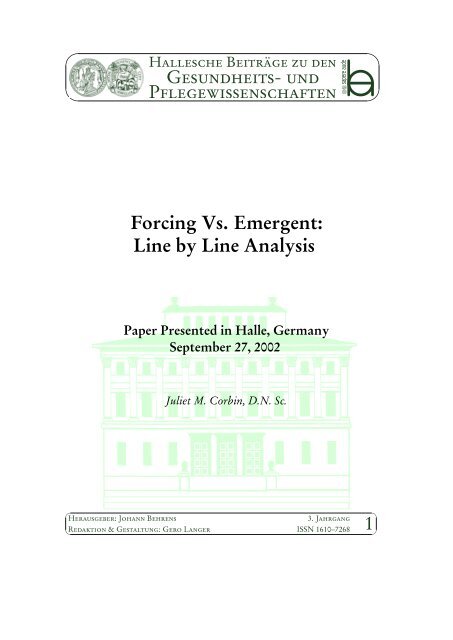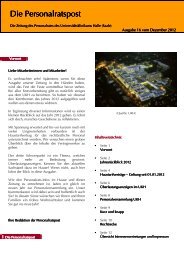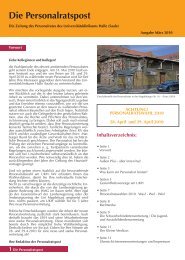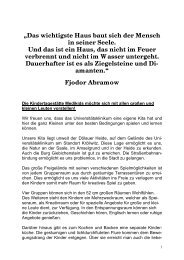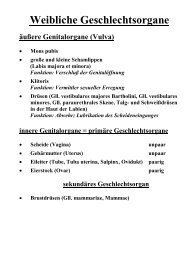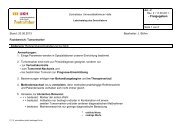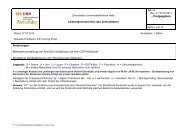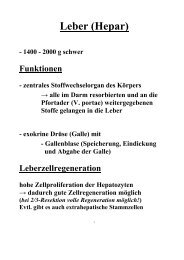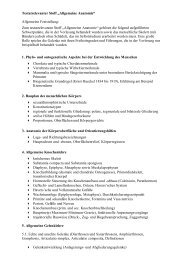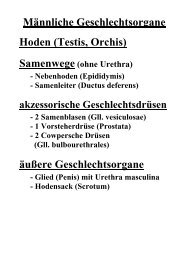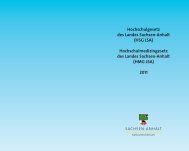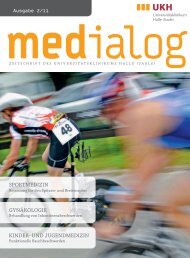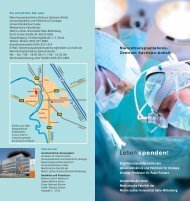Hallesche Beiträge zu den Gesundheits- und Pflegewissenschaften
Hallesche Beiträge zu den Gesundheits- und Pflegewissenschaften
Hallesche Beiträge zu den Gesundheits- und Pflegewissenschaften
You also want an ePaper? Increase the reach of your titles
YUMPU automatically turns print PDFs into web optimized ePapers that Google loves.
Vor der Veröffentlichung wer<strong>den</strong> <strong>Beiträge</strong> im üblichen »peer review«-Verfahren auf ihre Publikationswürdigkeit hin begutachtet.Außer der anonymen Beurteilung der Publikationswürdigkeit geben die Gutachten<strong>den</strong> in der Regel Anregungen für Verbesserungenan die Autorinnen <strong>und</strong> Autoren. Die Aufnahme der Anregungen wird nicht in einer zweiten Begutachtungsr<strong>und</strong>e geprüft. Daherkann nicht notwendigerweise davon ausgegangen wer<strong>den</strong>, daß die publizierten Fassungen allen Anregungen der Gutachten<strong>den</strong>entsprechen. Die Verantwortung für die publizierte Fassung liegt bei <strong>den</strong> Autorinnen <strong>und</strong> Autoren.Die Zeitschrift <strong>und</strong> alle in ihr enthaltenen <strong>Beiträge</strong> sind urheberrechtlich geschützt. Die Nut<strong>zu</strong>ng der Zeitschrift <strong>und</strong> der in ihrenthaltenen <strong>Beiträge</strong> ist insoweit frei, als nichtkommerziell handeln<strong>den</strong> Personen, Firmen, Einrichtungen etc. ein begrenztes Rechtauf nichtkommerzielle Nut<strong>zu</strong>ng <strong>und</strong> Vervielfältigung in analoger <strong>und</strong> digitaler Form eingeräumt wird. Das betrifft das La<strong>den</strong> <strong>und</strong>Speichern auf binäre Datenträger sowie das Ausdrucken <strong>und</strong> Kopieren auf Papier. Dabei obliegt dem Nutzer stets die vollständigeAngabe der Herkunft, bei elektronischer Nut<strong>zu</strong>ng auch die Sicherung dieser Bestimmungen.Es besteht – außer im Rahmen wissenschaftlicher <strong>und</strong> schulischer Veranstaltungen öffentlicher Träger – kein Recht auf Verbreitung.Es besteht kein Recht <strong>zu</strong>r öffentlichen Wiedergabe. Das Verbot schließt das Bereithalten <strong>zu</strong>m Abruf im Internet, die Verbreitungüber Newsgroups <strong>und</strong> per Mailinglisten ein, soweit dies durch die Redaktion – oder durch <strong>den</strong>/die Urheber des betreffen<strong>den</strong> Beitrags– nicht ausdrücklich genehmigt wurde. Darüber hinausgehende Nut<strong>zu</strong>ngen <strong>und</strong> Verwertungen sind ohne Zustimmung des Urhebersun<strong>zu</strong>lässig <strong>und</strong> strafbar.Eine Produktbezeichnung kann markenrechtlich geschützt sein, auch wenn bei ihrer Verwendung das Zeichen R○ oder ein andererHinweis fehlen sollte. Die angegebenen Dosierungen sollten mit <strong>den</strong> Angaben der Produkthersteller verglichen wer<strong>den</strong>. FürAngaben über Dosierungen <strong>und</strong> Applikationsformen kann keine Gewähr übernommen wer<strong>den</strong>.Gesetzt mit L A TEX 2ε in der Stempel GaramondRedaktionsschluß: 13th April 2004IMPRESSUMDie »<strong>Hallesche</strong>n <strong>Beiträge</strong> <strong>zu</strong>r <strong>Ges<strong>und</strong>heits</strong>- <strong>und</strong> Pflegewissenschaft« wer<strong>den</strong> herausgegeben von Prof. Dr. phil. habil. Johann BehrensRedaktion & Gestaltung: Dipl. Pflege- u. <strong>Ges<strong>und</strong>heits</strong>wiss. Gero LangerKontakt: Martin-Luther-Universität Halle-Wittenberg · Medizinische Fakultät · Institut für <strong>Ges<strong>und</strong>heits</strong>- <strong>und</strong> Pflegewissenschaft ·German Center for Evi<strong>den</strong>ce-based Nursing · Magdeburger Straße 27 · 06112 Halle/Saale · DeutschlandTelefon 0345 – 557 4450 · Fax 0345 – 557 4471 · E-Mail gero.langer@medizin.uni-halle.deWebsite http://www.medizin.uni-halle.de/journal/ISSN 1610–7268Alle Rechte vorbehalten.c○ Prof. Dr. Johann Behrens, Halle/Saale, Deutschland
Über die AutorinJuliet Corbin R.N., D.N.Sc. F.N.P. is an Adjunct Professor in the International Institutefor Qualitative Research at the University of Alberta, Edmonton Canada. She receivedher B.S. in Nursing from Arizona State University, her M.S. in Nursing from San JoseState University, and D.N.Sc. from the University of California, San Francisco. She wasa Post Doctoral Research Fellow in the Department of Social and Behavioral Scienceswith Dr. Anselm Strauss from September 1982 to January 1984. She then worked withDr. Strauss as a Research Associate from 1984 until 1996. Dr. Corbin taught in theschool of Nursing at San Jose State University from 1981 until May, 2000. She is coauthorwith Anselm Strauss of Basics of Qualitative Research 1990, 1997 and Gro<strong>und</strong>edTheory in Practice, 1997. She has given workshops on Gro<strong>und</strong>ed Theory and QualitativeMethods in Swe<strong>den</strong>, Germany, Korea, Norway, Mexico, and Canada. Her majorresearch and scholarly interests are in the areas of chronic illness, qualitative researchand theory development. Her published articles are related to these topics.J. M. Corbin (2004): Forcing Vs. Emergent: Line by Line Analysis<strong>Hallesche</strong> <strong>Beiträge</strong> <strong>zu</strong> <strong>den</strong> <strong>Ges<strong>und</strong>heits</strong>- <strong>und</strong> <strong>Pflegewissenschaften</strong>, 3. Jahrgang, Heft 1Seite 1
I’ve been asked here today to talk about line-by-line analysis. Though it is difficult toconvey in a short time all of the methodological implications contained within that shortphrase I’ll try. I’ll begin by presenting an overview of the process and end with a shortdemonstration of how line by line analysis is actually carried out.Line by line analysis or microanalysis as it is sometimes called is an analytic process,not particular to, but often associated with Gro<strong>und</strong>ed Theory Methodology.I would describe it as a way of thinking about data, a tool for opening up qualitativetext. It is used to break text down into discrete parts, then to put it back together innew ways. In this way discoveries are made. In fact, most scientific discoveries are notmade through »hard« science but by someone noting something significant in a piece ofdata then realizing the implications of what is observed. That is what we are trying to dowhen we do line-by-line analysis.Line by line analysis is not limited to looking at data line by line. Rather it refers toexamining a particular piece of a larger set of data. That piece could be a word, a phrase,a sentence, or paragraph. Since interviews and observations are often very lengthy, itdoesn’t make sense to scrutinize every word on the page line by line, though one could.Usually, the word or phrase chosen for closer inspection is something that catches theanalyst attention. Of course, one could say that all data is significant but not all of itstrikes the analyst consciousness in the same way. That data which catches attention issomething that makes the analyst say, hmm, »there appears to be something significantgoing on here. Let me see if I can uncover what that is«.Line by line analysis is an analytic technique perfected by Anselm Strauss. For him itwas the heart of analysis, everything else stemming from there. The logic behind microanalysisis quite simple. Its purpose is to discover and develop concepts, their propertiesand dimensions. Concepts provide the fo<strong>und</strong>ation for theory and properties and dimensionsgive a theory its specificity, explanatory power, and <strong>den</strong>sity. But the benefits ofdoing line-by-line analysis go beyond that. It enables the analyst to break through assumptionsand conventional thought to see other possibilities in the data. It allows theresearcher to dig beneath the surface of data in order to determine what is really goingon.Without entering into what I believe is a nonproductive controversy, I want to mentionsomething about Forcing versus Emergent. Naturally, those of us who utilize Strauss’approach to data analysis do not believe that we are forcing data. Just as we don’t believethat data just emerges. We take the position that analysis is an interaction between theanalyst and the data. As such the analyst brings his or her own set of analytic eyeglassesto the data, which not only colors interpretation but also one’s vision, the ability to seewhat is there. To date, I have never sat down with a group of colleagues or stu<strong>den</strong>tsto do analysis without all of the prejudices, assumptions, attitudes, and interests comingthrough. The worst part is that for the most part, we are unaware of how our perspectivesinfluence what we see and how we interpret what is on the pages in front of us. That iswhy I have such a difficult time with the term »emerge«. How can something emergewithout it emerging through an analytic lens. What emerges is what the analyst allows toemerge. Furthermore, how can an analyst look at data and not have some sort of mentalresponse to it and with it. Data doesn’t wave red flags and say: »Hey, I’m importantJ. M. Corbin (2004): Forcing Vs. Emergent: Line by Line Analysis<strong>Hallesche</strong> <strong>Beiträge</strong> <strong>zu</strong> <strong>den</strong> <strong>Ges<strong>und</strong>heits</strong>- <strong>und</strong> <strong>Pflegewissenschaften</strong>, 3. Jahrgang, Heft 1Seite 2
context. Nothing according to Anselm’s way of thinking was simply black and white.Life to him was complex and it was important to him that analysts capture as much ofthat complexity as possible in their research. Since line by line analysis involves examiningdetails through a multicolored lens is there any wonder why it was so important toAnselm’s way of thinking?It was a joy to watch Anselm at work, to work with him. He had such a seminal mindand would draw upon his stored knowledge to gain insight and <strong>und</strong>erstanding into newsituations. It was amazing to see what he could do analytically with one little phraseor paragraph. From a few words he would generate so many questions and thoughts,ideas to be followed up on through theoretical sampling or that gave new insight intodata. For example we were doing a study on head nurses and the articulation of work inhospitals. We had been analyzing data for months but somehow the concept of powerhad never surfaced. It may have been there but we were too insensitive to notice. Thenone day, we coded an inci<strong>den</strong>t as power. Then we went to work on the concept of power,what does it mean here, who has power, how does it manifest itself, and so on. We wereexploring power as one would a brilliant cut diamond, examining its many facets andmanifestations. In this way we were increasing our sensitivity so that when we wentback to the data, inci<strong>den</strong>ts that we never before coded as power jumped off the page. Butthey didn’t jump out at us until we had developed this sensitivity by thinking about andplaying with the concept of power. Is this process of working with data something thatone would consider »forcing«? I think not, but like everything else that has to do withanalysis, it is all a matter of definition and interpretation.What were the analytic techniques that Anselm used to dig beneath the surface of data?Mine it like gold, as he would say. I’d like to explain some of those techniques.1. The first is the making of comparisons, meaning that an inci<strong>den</strong>t is comparedagainst another inci<strong>den</strong>t in order to determine if these are conceptually the same.Those that are similar are grouped together.2. The second is the asking of generative questions. To name a few, questions suchas what is going on here; also who, what, where, when, how come, how, withwhat consequences. Anselm always said »Any question that helps to i<strong>den</strong>tify or<strong>und</strong>erstand a concept is a good question.«3. The making of theoretical comparisons. This is where Anselm excelled. Doingtheoretical comparisons involves working with concepts, not descriptive material.I would describe making theoretical comparisons something akin to brainstorming.Once there is a concept, such as »making arrangements« one draws upon life experienceor the literature in order to try to uncover the meaning of this concept anddiscover possible properties and dimensions. For example if one were studyingnurses working in an intensive care unit and one came upon the phrase »she wasexperienced nurse« the analyst might want to know what is meant by »an experiencednurse«. Suppose the information is not forthcoming in the data. It may bethere but somehow the analyst is blocked and not seeing it. So the analyst startsJ. M. Corbin (2004): Forcing Vs. Emergent: Line by Line Analysis<strong>Hallesche</strong> <strong>Beiträge</strong> <strong>zu</strong> <strong>den</strong> <strong>Ges<strong>und</strong>heits</strong>- <strong>und</strong> <strong>Pflegewissenschaften</strong>, 3. Jahrgang, Heft 1Seite 4
7. Waving the red flag in another analytic technique. Whenever a respon<strong>den</strong>t sayssomething like always, sometimes, never, the analyst should stop and question thedata because implied in that piece of data are the informant’s beliefs and assumptions.This is the time to ask a lot of questions of the data, such as how come always,could there be any exceptions, and so on.8. Then there is looking for specific words such as »when« and »if« because they pointto conditions that help the analyst locate a concept in context.In summary, as you can see, doing line by line analysis is a very generative and dynamicprocess. It encompasses both what we refer to open and axial coding. Out of themicroanalysis come memos, theoretical sampling, and eventual saturation. When donewith diligence it enables the research to build complete and detailed explanations aboutsome facet of life.J. M. Corbin (2004): Forcing Vs. Emergent: Line by Line Analysis<strong>Hallesche</strong> <strong>Beiträge</strong> <strong>zu</strong> <strong>den</strong> <strong>Ges<strong>und</strong>heits</strong>- <strong>und</strong> <strong>Pflegewissenschaften</strong>, 3. Jahrgang, Heft 1Seite 6


